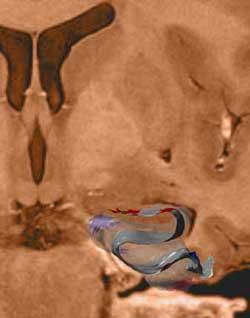Map of memory

The temporal central lobe is not easy to analyze. In fact, it is included and therefore some important areas cannot be seen by functional MRI. However, these researchers have managed to overcome the problem: with a method similar to that used by mathematicians to turn the balls of the world into a flat map, they have managed to map the temporal central lobe and see the borders between the spaces.
Researchers have focused on areas that are activated when saving and recovering memory. Research participants had to combine different names with their faces. In doing so, it is observed that part of the central temporal lobe, the hippocampus, increases the activity of three zones. In addition, this activity is at first more intense and, as names and faces become more popular, the activity decreases. Then, by recovering the name of each face, they have seen that the activity is aggravated in another area of the hippocampus.
Apparently, this research has shown that the temporal central lobe distributes the works when saving and recovering things in memory. However, there are still many aspects to clarify on this issue.
Buletina
Bidali zure helbide elektronikoa eta jaso asteroko buletina zure sarrera-ontzian











